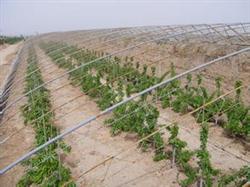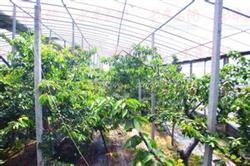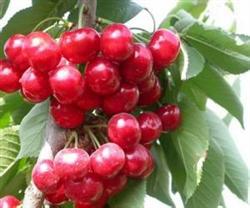Greenhouse Management Technology of Big Cherry

1. Soil, fertilizer and water management Big Cherry belongs to shallow root tree species, and the root system is breathing vigorously, so it is necessary to meet the requirements of water, fertilizer, gas and heat for root growth as far as possible. Each growing season should be ploughed at least 4-5 times, and the suitable depth of 5~10cm is to weed and preserve soil moisture, so as to activate the soil and enhance its permeability. Shallow ploughing should be carried out after harvest to promote root regeneration and growth. The application of basic fertilizer should be carried out in late summer or early autumn, and the main fertilizers were organic manure, chicken manure and pig manure. Before freezing, one frozen water should be watered once during the fruit expansion period. 2. Plastic pruning technique pruning can be done through these two methods: 1) natural happy shape. Dry height 20~40cm, no central trunk, the whole tree has 2-4 main branches, the opening angle is about 40 °, each main branch is equipped with 2-3 layers of lateral branches, each layer is separated by 30cm, and there are various types of fruiting branch groups on the lateral branches. 2) Natural spindle shape. Dry height 40~60cm, the central trunk is equipped with 6-10 main branches with uniaxial extension, the angle opening is almost horizontal, and there are a large number of fruiting branches above. When pruning, you should drop your head in time to control the height of the tree. During plastic surgery, the 50cm was fixed and dried in the same year, and the long branches with strong growth and good orientation were selected as the main branches, which were drawn into a horizontal angle in the growing season. In the second year of winter pruning, the central trunk was extended and the branches were cut short by 40~60cm. The opening angle of the main branch in the growing season, and the strong branches on the back of the main branch pick out the heart. When cutting in winter, the competitive branches and upper dorsal branches should be thinned or cut short, and the rest of the oblique branches and moderate branches can be gently or gently cut. In the third year, the 50cm was kept in the central stem, the angle of opening continued in the growing season, and the coring of the upper dorsal branch and the long branch of the inner chamber were cultured into the fruiting branch group. 3. Pruning techniques 1) pruning during the growing period. It was mainly carried out during the period of shoot growth and after fruit harvest. The former is mainly to restrain the growth of new shoots, promote branching, and can be carried out many times. The pruning after fruit picking is mainly to thinning branches, ensuring the ventilation and light transmission of the tree, balancing the tree potential and promoting the differentiation of flower buds. The 2-year-old branches were truncated at the axillary buds and then thinned from the base after the fruit. 2) pruning during dormancy. Young trees should be cut short to promote branching, increase bouquet-like fruit branches and leaf branches, and retract properly after fruiting, so as to maintain tree growth and improve fruiting ability. 4. The cooling requirement of buckle film and film removal cherry is generally below 7-2 ℃ for 1440h, and the film fastening time is in mid-late December. Except for the film 10 days before fruit harvest, the method is to uncover the film on both sides first, exercise for 2-3 days, and then uncover most of the film to increase light, promote coloring, and improve the sugar content and quality of the fruit. The film mulching can be completely removed after fruit harvest, and the film can be re-covered when the temperature drops or it rains. 5. The control of temperature can also increase the ground temperature by 2 / 3 ℃ in greenhouse. From plastic film mulching to germination, it is controlled at 18: 20 ℃ in daytime and 2: 5 ℃ at night; from germination to flowering, it is 18: 20 ℃ in daytime and 6: 7 ℃ at night; during flowering, the daytime temperature is 20: 22 ℃, which must not exceed 25 ℃; during flowering period, 20: 22 ℃ in daytime, 7: 8 ℃ at night; 22: 25 ℃ in daytime, 10: 12 ℃ at night; 22: 25 ℃ in daytime, 12: 15 ℃ at night. If the temperature exceeds 30 ℃ for several days, the coloring is bad, the flower bud differentiation is not good, and the next annual yield is affected. 6, humidity regulation from plastic film mulching to germination, the air relative humidity is about 80%, too low and irregular flowering, vulnerable to high temperature; too high is disadvantageous to pollen and germination, and is prone to disease. The relative humidity at flowering stage should be between 40% and 60%, and the stigma is easy to dry when the humidity is low, which affects pollination. The humidity during the fruit expansion period was controlled at 60%. The humidity from coloring to maturity is controlled at about 50%. Soil moisture can be regulated by irrigation, and more water is needed in the fruit expansion period, but in this period, small water irrigation is suitable for 10~15mm irrigation each time. 5~7mm is suitable for irrigation before fruit ripening. 7. Pest control 7.1 small purple-brown spots appeared in the early stage of perforated leaves, but dried up and fell off in the later stage, resulting in leaf perforation and early defoliation in severe cases. Strengthening the management of fertilizer and water, strengthening the tree potential, improving the ability of disease resistance, cutting off diseased branches and eliminating diseased leaves are the foundation of prevention and treatment of this disease. 7.2 Gummosis mainly occurred in the branches, especially in the bifurcations. Generally, the disease begins after harvest and aggravates with the increase of rainfall. It is often caused by freezing injury, insect pest and mechanical damage. Therefore, the most important thing to prevent and cure this disease is to protect the tree body, to apply white on the tree trunk and branches before winter to prevent frost damage, to control stem borer, to eliminate mechanical damage, to scrape the branches with gum disease in time, and to apply thinning agent to prevent spread. 7.3 Red-necked longicorn beetle this pest is an important pest to damage branches. The main control methods are as follows: 1) to capture adults artificially during the occurrence of adults. 2) before the adult spawning, apply the whitening agent (10 parts of quicklime, 1 part of sulfur, 40 parts of water) on the trunk and side branches to prevent spawning. 3) wormholes were found when scraping, and the larvae damaged in the phloem were killed or fished out with needles or wire.
- Prev

There are ten ways to manage Big Cherry in summer.
1. Soil fertilizer and water management big cherry fruit development period is short, need nutrient concentration, pay attention to pre-flowering, fruit development period and after fruit harvest, autumn topdressing, the first time mainly nitrogen fertilizer combined with phosphorus and potassium fertilizer, the second time by phosphorus and potassium fertilizer, after fruit harvest mainly by compound fertilizer, can also apply rotten familiar manure, rotten bean cake water and so on (soil fertilizer.
- Next

Summer management techniques of big cherry trees
Summer is the key period for the growth of big cherry trees, and diseases and insect pests are also very easy to occur. therefore, fruit growers should pay attention to the management of big cherry trees in summer. Do a good job in the following points to make the big cherry tree smoothly through the summer growing season. Coring summer cherry trees grow vigorously, with too many leaves and branches for the coming year.
Related
- Moge, come on! The staff of the peasant association in the producing area of cantaloupe were frightened when the crowd gathered.
- Causes and Solutions of low Fruit setting rate of Apple
- Symptoms and control measures of passion fruit virus disease
- Fruit growing lesson: how do apple orchards keep high yields?
- Can you build orchards in the mountains? What are the pros and cons?
- How to manage the coloring period of Crisson grape?
- This paper introduces the processing technology of two kinds of fig products.
- How much is a month for retired teachers in rural areas by 2020?
- How can strawberry planting increase sugar content? We should pay attention to management in many aspects.
- What are the cultivation techniques on how to improve the yield of golden fruit?

